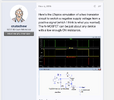Hello,...
I am very curious how you were able to import the AO6408 VDMOS model into LTSPICE.
I am new to LTSPICE and trying to create a circuit you designed (see attached file) on Nov 4, 2017.
I believe you are converting a positive voltage into a negative voltage.
My end goal..is I am helping a retired friend (former supervisor) design some circuits for a 1956. Bendix Re-Build....
to translate -20V logic signals to logic +3V....so something like your circuit is where I am starting.
My call sign here is Ches74.
I really hope to hear from you...will be very cool ....thought your circuit was awesome.
I am very curious how you were able to import the AO6408 VDMOS model into LTSPICE.
I am new to LTSPICE and trying to create a circuit you designed (see attached file) on Nov 4, 2017.
I believe you are converting a positive voltage into a negative voltage.
My end goal..is I am helping a retired friend (former supervisor) design some circuits for a 1956. Bendix Re-Build....
to translate -20V logic signals to logic +3V....so something like your circuit is where I am starting.
My call sign here is Ches74.
I really hope to hear from you...will be very cool ....thought your circuit was awesome.


